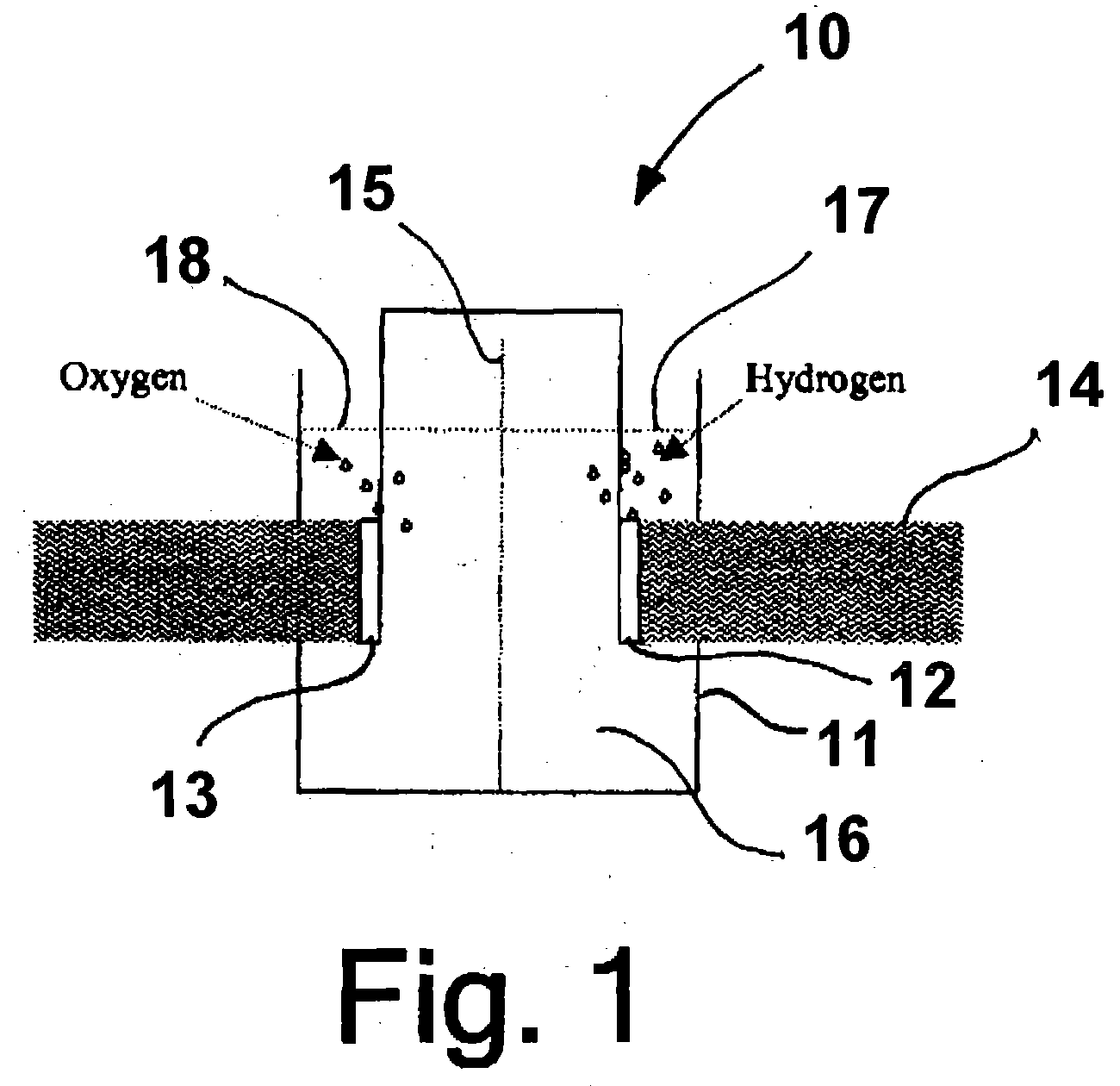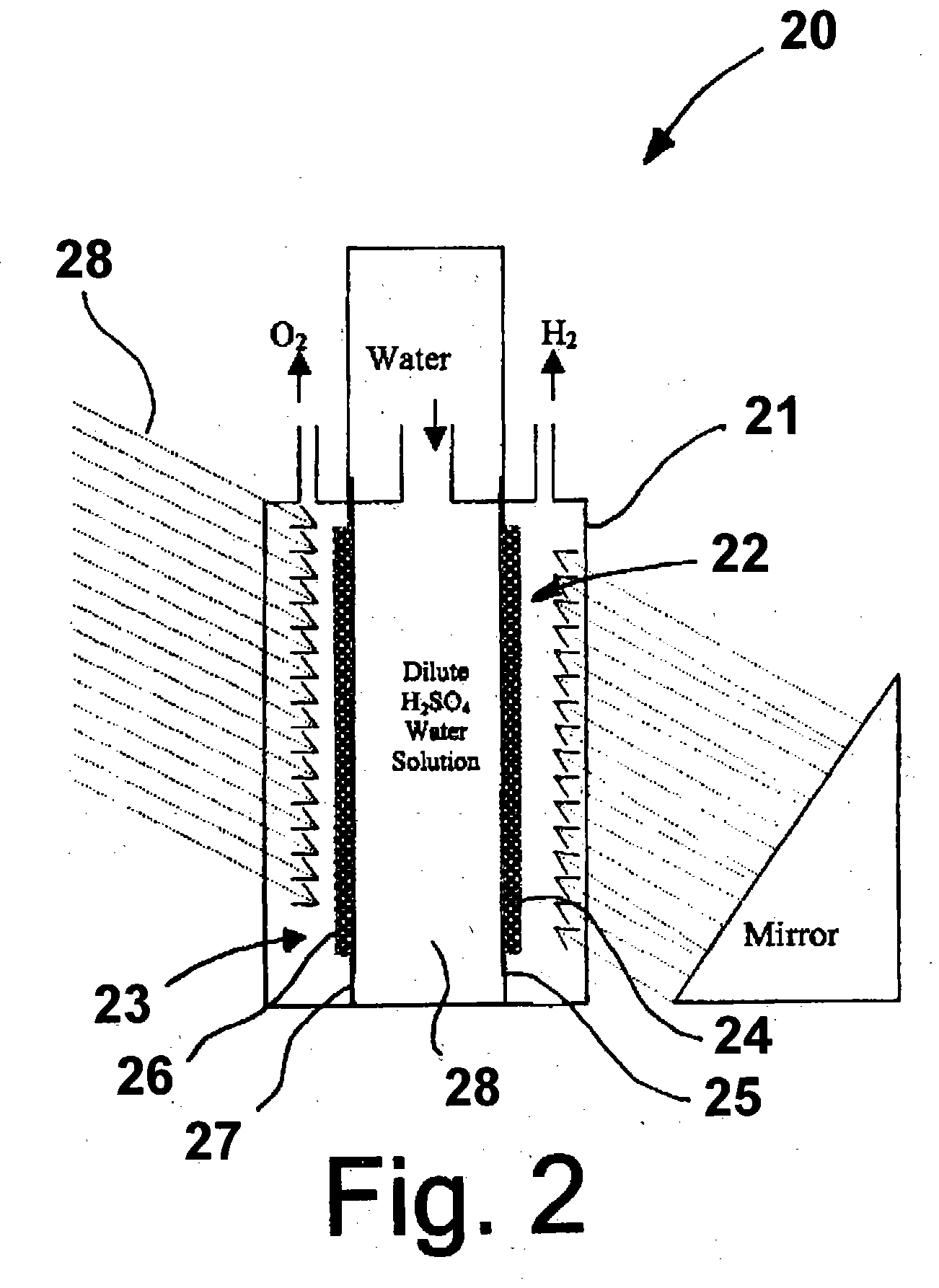Photoelectrolysis of water using proton exchange membranes
a proton exchange membrane and photoelectrolysis technology, applied in the field of photoelectrolysis, can solve the problems of low photoelectrode efficiency, additional hindrance in current design of photoelectrodes, poor stability, etc., and achieve the effect of eliminating water surface tension, improving efficiency and performance stability, and not incurring energy losses
- Summary
- Abstract
- Description
- Claims
- Application Information
AI Technical Summary
Benefits of technology
Problems solved by technology
Method used
Image
Examples
example 1
A photoelectrode in accordance with one embodiment of this invention is produced by dissolving hydrogen hexachloroplatinate (IV) (Aldrich) in water as a 100 ml 1% (W / W) solution. 0.2 g of TiO2 (Rutile) (Aldrich) is mixed into the solution [Pt:TiO2 (mole ratio)=1:1]. The solution is titrated with 1% NaBH4 (0.1 g NaBH4) (Aldrich). 0.1 g XC 72R carbon black, available from Cabot Corporation, Alpharetta, Ga., is added to the solution, which is then stirred well. The resulting suspension is filtered and washed until there are no chloride ions in the powder. The powder is then dried at 450° C. for about 2 hours. The dried powder is then ground and mixed with isopropanol and water with 20% NAFION (DuPont) thereby forming an ink. The ink is applied to a NAFION proton exchange membrane by any suitable coating technique, resulting in the formation of a photoanode. In a similar fashion, a photocathode can be produced using a p-type semiconductor instead of n-TiO2.
example 2
In this example, rutile type TiO2 is treated with TiCl4 solution. The TiCl4-modified TiO2 is sintered at 450° C. to produce a Ti-rich TiO2 (n-type) semiconductor powder. The powder is then mixed with isopropanol, 10% by weight XC-72R carbon black, and 20% by weight NAFION emulsion to form an ink solution. The ink is applied to the NAFION membrane by the decal method or other suitable coating techniques, resulting in formation of a photoanode. The photocathode is made from sintering TiO2 in a sulfur vapor environment at 450° C. The TiO2 powder is mixed with 1% by weight sulfur powder, which mixture is then sintered for about two hours at 450° C. The sintered mixture is then ground to mix with carbon black and NAFION as previously described.
example 3
In this example, a photoelectrode is produced as before with the exception that the 10%. by weight carbon black and 20% by weight NAFION are replaced by sulfonated polyaniline, i.e. Polyaniline-campphorsulfonic acid (PANI-CSA0.5). Polyaniline powder is mixed with campphorsulfonic acid to form PANI-CSA0.5, which is then dissolved in m-cresol. The resulting solution is then added to the TiO2 powder to form an ink comprising 70% by weight semiconductor catalyst and 30% by weight PANI-CSA0.5.
PUM
| Property | Measurement | Unit |
|---|---|---|
| semiconductor | aaaaa | aaaaa |
| band gap | aaaaa | aaaaa |
| electrically conductive | aaaaa | aaaaa |
Abstract
Description
Claims
Application Information
 Login to View More
Login to View More - R&D
- Intellectual Property
- Life Sciences
- Materials
- Tech Scout
- Unparalleled Data Quality
- Higher Quality Content
- 60% Fewer Hallucinations
Browse by: Latest US Patents, China's latest patents, Technical Efficacy Thesaurus, Application Domain, Technology Topic, Popular Technical Reports.
© 2025 PatSnap. All rights reserved.Legal|Privacy policy|Modern Slavery Act Transparency Statement|Sitemap|About US| Contact US: help@patsnap.com



